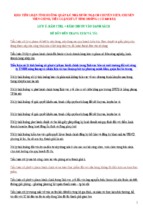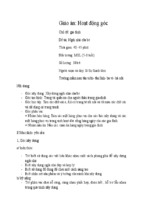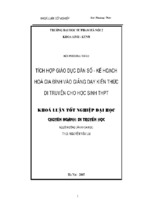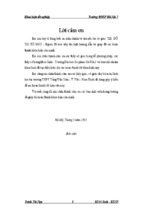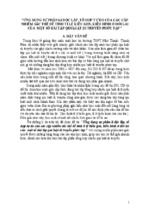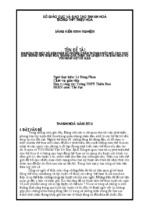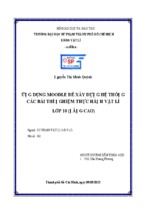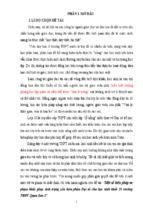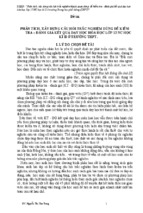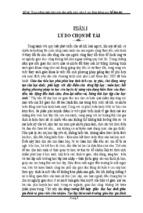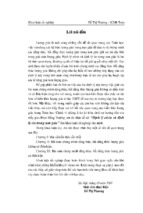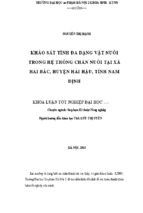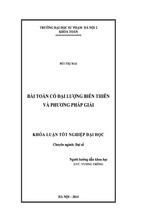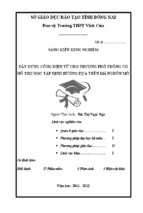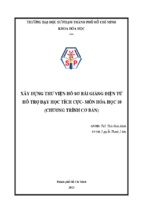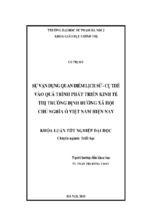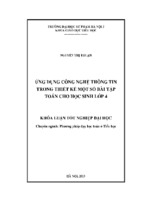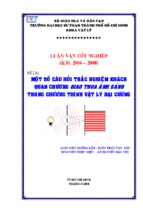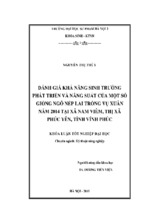SỞ GIÁO DỤC VÀ ĐÀO TẠO ĐỒNG NAI
TRƯỜNG THPT VĨNH CỬU
Mã số: ................................
SÁNG KIẾN
Người thực hiện: Lê Thị Ngọc Thiện
Lĩnh vực nghiên cứu:
- Quản lý giáo dục
- Phương pháp dạy học bộ môn: Anh Văn
- Lĩnh vực khác:
Có đính kèm: Các sản phẩm không thể hiện trong bản in SKKN
Mô hình Đĩa CD (DVD) Phim ảnh Hiện vật khác
Năm học: 2019-2020
SỞ GIÁO DỤC VÀ ĐÀO TẠO ĐỒNG NAI
TRƯỜNG THPT VĨNH CỬU
SÁNG KIẾN
Người thực hiện: Lê Thị Ngọc Thiện
Lĩnh vực nghiên cứu:
- Quản lý giáo dục
- Phương pháp giáo dục
- Phương pháp dạy học bộ môn: Anh Văn
- Lĩnh vực khác:
Năm học: 2019-2020
MỤC LỤC
Trang
INTRODUCTION ....................................................................................................................1
1. Context of the solution .................................................................................... 1
2. Reasons for choosing the topic ....................................................................... 1
3. Study scope and study subjects ....................................................................... 1
4. Objectives of the research ............................................................................... 1
CONTENTS ...............................................................................................................................2
I. THEORETICAL BACKGROUND AND REALITY ....................................... 2
1. Theoretical background .................................................................................. 2
2. Reality............................................................................................................. 2
II. CONTENTS OF INVENTION ......................................................................... 3
1. Implementation ............................................................................................... 3
2. Advantages and disadvantages........................................................................ 7
3. Evaluation ....................................................................................................... 8
a) New points .................................................................................................. 8
b) Effects ......................................................................................................... 8
c) Application and results ............................................................................. 11
CONCLUSION........................................................................................................................11
1. Experiences drawn from the process of applying the invention. ........... Error!
Bookmark not defined.
2. Recommendation for implementing and applying the invention
intoreality.Error! Bookmark not defined.
3. Declaration .................................................... Error! Bookmark not defined.
APPENDICES ...........................................................................................................................1
REFERENCES ..........................................................................................................................1
DANH MỤC CHỮ CÁI VIẾT TẮT
STT
Từ viết tắt
Nội dung viết tắt
1
TESOL
Teaching English to Speakers of other Languages
2
EFL
English as a Foreign Language
3
M.A
Master of Arts
THÔNG TIN CHUNG VỀ SÁNG KIẾN
1. Tên sáng kiến: The use and the effectiveness of using reading in teaching
writing at Vinh Cuu high school
2. Lĩnh vực áp dụng sáng kiến: Giảng dạy Tiếng Anh
3. Tác giả:
- Họ và tên: Lê Thị Ngọc Thiện
Nam (nữ): Nữ
- Trình độ chuyên môn: Cử nhân Anh Văn
- Chức vụ, đơn vị công tác: Giáo viên, THPT Vĩnh Cửu
- Điện thoại: 079 2826 815. Email:
[email protected]
Tỷ lệ đóng góp tạo ra sáng kiến (%): 100%.
1
THE USE AND THE EFECTIVENESS OF USING READING IN
TEACHING WRITING AT VINH CUU HIGH SCHOOL
INTRODUCTION
1. Context of the solution
It is stated that writing is a necessary and crucial skill in language learning as
well as English learning (Ariyanti, 2016; Pham & Nguyen, 2014). However,
among the four skills, writing is considered to be the most difficult one. It is,
therefore the writer investigates the use and the effectiveness of using reading in
teaching writing. 23 teachers were chosen randomly to take part in this research.
The participants are graduated students who are learning the first stage of Master
of TESOL course at Ho Chi Minh City Open University. Two questionnaires were
designed to collect teachers’ opinions in order to answer two research questions.
The findings revealed that although this technique is effective, there are still many
obstacles that were needed to be overcome.
2. Reasons for choosing the topic
Writing skill is usually taught separately from other skills (speaking, reading
and listening), which causes difficulties for EFL students in learning writing skills
(Habibi, Salleh, & Singh, 2015). Considering the difficulties that learners may deal
with, many researchers suggested the use of reading as a teaching technique to
support and enhance EFL students’ writing abilities (AlOmrani, 2014; Habibi et
al., 2015; & Grabe & Zhang, 2013). This writing also aims at investigating the
connection between Reading and Writing, the effectiveness of integrating reading
skills and writing skills on EFL learners, and the use and the effectiveness of this
technique in Vinh Cuu classrooms
3. Study scope and study subjects
The area of this study is to investigate the connection between reading and
writing. Basing on this, the study attempts to examine how to apply reading in
teaching writing at Vinhcuu high school.
4. Objectives of the research
The aim of this research is to investigate the use and the effectiveness of
taking advantage of reading in teaching writing in Vietnamese classrooms. At the
same time, it also creates the environments for students to write confidently basing
on reading skills.
2
CONTENTS
I. THEORETICAL BACKGROUND AND REALITY
1. Theoretical background
Eisterhold (1990, as cited in AlOmrani, 2014) interpreted the connection
between reading and writing by using three hypotheses, which are “directional
hypothesis, non-directional hypothesis, and bidirectional hypothesis” (Eisterhold,
1990, as cited in AlOmrani, 2014, p. 102). Directional hypothesis claimed that
information/knowledge obtained from reading materials will be used in writing,
which means that the use of reading is supporting writing (AlOmrani, 2014).
Meanwhile, non-directional hypothesis means that information/knowledge learned
from writing can be used in reading and vice versa, which means reading is used to
assist writing and vice versa (AlOmrani, 2014). Bidirectional hypothesis stated that
“reading and writing are both interactive and interdependent” (AlOmrani, 2014, p.
103). This means that the change in students’ language proficiency may lead to the
change in their writing abilities or reading abilities, which can be understood that if
their writing abilities develop, their reading abilities will develop and vice versa
(AlOmrani, 2014).
Although the relationship between receptive skills and productive skills did
not state that students need to become good readers to be good writers, it did
interpret the reason for integrating reading skills and writing skills in teaching.
Meanwhile, the hypotheses of Eisterhold (1990, as cited in AlOmrani, 2014)
explained specifically the positive impact of reading and writing on each other.
The researcher claimed that the proficiency in students’ writing skills have the
influence on the proficiency in students’ reading skills and vice versa. However,
the connection between reading and writing in this technique can be interpreted by
directional hypothesis, because this technique was made to teach writing skills
with reading as the main support of writing (AlOmrani, 2014).
The hypotheses of Eisterhold (1990, as cited in AlOmrani, 2014) explained
specifically the positive impact of reading and writing on each other. The
researchers claimed that the proficiency in students’ writing skills have the
influence on the proficiency in students’ reading skills and vice versa. However,
the connection between reading and writing in this technique can be interpreted by
directional hypothesis, because this technique was made to teach writing skills
with reading as the main support of writing (AlOmrani, 2014). The use of reading
is suggested as an effective technique to improve EFL students’ writing skills
(AlOmrani, 2014; Grabe & Zhang, 2013 & Habibi et al., 2015). Hence, in order to
be aware of the feasibility and effectiveness of the use of reading in teaching
writing, many researchers and teachers started to do more research on applying this
technique in teaching writing as well as apply it in their classes.
2. Reality
Grabe and Zhang (2013) almost all students have to face to many difficulties in
learning English writing skill such as “less exposure to English texts, and much
3
more limited vocabulary knowledge” (p. 108). In addition, instead of paying
attention to “the content and the organizations of ideas” (Rass), EFL students are
required to focus on “choosing proper words, using correct grammatical patterns
and checking spelling of words” (Tangpermpoon, 2008, as cited in Habibi et al.,
2015, p. 1116). As a teacher at Vinh Cuu high school, the writer has noticed some
common mistakes that many students have no real understanding of lexis of the
language and just apply the grammatical rules mechanically. As a result, they run
the risk of producing grammatically correct but semantically inappropriate or
anomalous sentences. Some students tend to translate mechanically from
Vietnamese into English and use inaccurate words. They would like to write but
they feel that they do not have enough confidence and feel afraid of giving their
writing work to their teachers or friends. With the above mentioned situations, the
researcher conducts a study to investigate the use of reading as a teaching
technique to support and enhance EFL students’ writing abilities.
II. CONTENTS OF INVENTION
1. Implementation
The writer has found out the connection between the two skills Reading and
Writing. The relation between reading and writing can be interpreted by the
relationship between receptive skills and productive skills. According to Golkova
and Hubackova (2014), listening and reading are passive skills, which are
considered as receptive skills, because these 2 skills are used to receive and decode
accurately information/knowledge in order to understand them (Bhatt & Lilian,
2016). Meanwhile speaking and writing are active skills, which are considered as
productive skills (Golkova & Hubackova, 2014) because they are used to produce
language (Masduqi, 2016). It is stated that “if a learning process lacks one of them
[receptive skills and productive skills], the final outcome will not be completed”
(Golkova & Hubackova, 2014, p. 478). For example, students read grammatical
structures, which means that they are absorbing theories and rules. Thus, they need
reading which is the practice to help them remember and use these grammatical
structures effectively and fluently. Hence, “both types of skills [productive and
receptive] are inseparable and one cannot exist without the other” (Golkova &
Hubackova, 2014, p. 478).
As mentioned above, the use of reading is an effective technique to teach
writing skills (AlOmrani, 2014; Grabe & Zhang, 2013 & Habibi et al., 2015).
However, the use of this technique in Vietnam is still a question. In order to
examine the use and the effectiveness of integrating English writing skills and
English reading skills Vietnamese classrooms, the writing is designed to answer 2
following questions:
1. Do English teachers in Vietnam use reading to improve students’ writing
skills?
2. Does the use of reading in teaching writing improve Vietnamese students’
English writing skills?
4
Methodology
Participants: The surveys were carried out at the two classes the writer has
taught: 11A2, 11A10 with eighty participants who are in the second term of the
school and 23 other teachers were chosen randomly to take part in this research.
The participants are graduate students who are learning the first stage of Master of
TESOL course at Ho Chi Minh City Open University. There are 5 teachers who are
teaching at English language centers, while there are 13 teachers from state schools
in Ho Chi Minh city. Another 5 teachers are teaching at private schools. In
addition, around 30% of them have over 5 years teaching experience.
Data collection
Teachers were given questionnaires to elicit information on the respondents.
Two questionnaires were designed to collect teachers’ opinions in order to answer
two research questions. The first questionnaire includes 7 questions. The first and
second questions are used to ask teachers’ teaching experience and institution. The
next 5 questions are used to find out teachers’ acknowledgment of this technique
and the use of it in their classes. Meanwhile, the second questionnaire has 6
questions, which is used to elicit the effectiveness of this technique by asking
teachers who applied it.
Findings and discussion
Research question 1: Do English teachers in Vietnam use reading to improve
students’ writing skills?
The data of chart 1 was collected from the questionnaire 1. According to the
chart, there were 5 teachers who confirmed that they did not know this technique,
because of their old universities, TESOL training courses or the current Master of
TESOL did not teach them. Hence, they could not apply this technique in their
classes.
5
On the other hand, regarding the chart 2, the rest of 23 teachers (18 teachers)
know this technique. Most of them (11 teachers) confirmed that their old
universities, TESOL training courses and Master of TESOL taught them this
technique. Meanwhile, 5 of them know this technique through reading books or
journal articles of teaching writing. This means that they have interest in teaching
writing. The rest of them (2 teachers) know this technique because their colleagues
introduced it to them. However, there were 5 teachers did not use this technique to
teach writing, even though they know it. The reasons for this are shown in the chart
3.
To conclude, there were 23 teachers, who were asked about integrating
reading skills with writing skills. However, just 18 teachers know this technique.
Although there were 18 teachers who know this technique, just 13 teachers (around
57%) applied the use of reading in teaching writing in order to improve their
students’ writing skills. Therefore, it can be stated that there were a positive
number of teachers paid attention to the use of reading in teaching writing and
applied this technique in their classes.
6
Research question 2: Does the use of reading in teaching writing improve
Vietnamese students’ English writing skills?
In order to answer this question, 13 teachers, who used this technique, were
asked to answer questionnaire 2 in order to elicit their evaluation of this technique.
Considering answers collected, 5 teachers stated that their students’ writing skills
were improved after using reading to support and enhance students’ writing
abilities. The chart 4 below displays these 5 teachers’ evaluation of advantages that
this technique brought to their students.
Regarding the chart 4, after applying this technique in their classes, all 5
teachers believed that their students’ accuracy of using grammar and punctuation
was developed as well as their ability of arranging logically their writing’s ideas.
In addition, 4 of them confirmed the development in their students’ writing content
as well as the improvement in writing’s coherence and cohesion of their students.
Meanwhile, they realized that their students could not use complex grammar
structures fluently even after using this technique. Considering these figures, it can
be claimed that the use of reading did have a positive impact on students’ writing
skills, especially improving the use of grammar and punctuation and the
organization of writing’s ideas. This is a basis of the development in writing’s
content and writing’s coherence and cohesion. However, considering the fact that
students were not able to use complex grammatical structures, teachers need to pay
more attention to students’ grammar.
The rest of them (8 teachers) claimed that this technique is ineffective,
because they had to cope with some obstacles.
7
According to the chart 5, 6 teachers claimed that their students lacked reading
comprehension skill, while there are 5 teachers stated that the difficulty is students
did not know how to use information/knowledge obtained from assigned reading
materials in their writing. In addition, a half of them (4 teachers) pointed out that
the fact that students did not read assigned reading materials was also an obstacle.
Considering these figures, it can be stated that the lack of reading comprehension
skill was the main problem, which meant students might have limited
understanding of assigned reading materials; therefore, they could not obtain any
information or knowledge to support their writing. Moreover, the lack of reading
assigned reading materials could be the result of the lack of reading comprehension
skills as well as the difficulty level of assigned reading materials and students’
attitudes and low-motivation. Therefore, teachers need to improve their students
reading comprehension skill as well as choose reading materials that can interest
students and are not beyond their English level.
2. Advantages and disadvantages
a) Advantages
The use of reading is supporting writing (AlOmrani, 2014). Meanwhile, nondirectional hypothesis means that information/knowledge learned from writing can
be used in reading and vice versa, which means reading is used to assist writing
and vice versa (AlOmrani, 2014). Bidirectional hypothesis stated that “reading and
writing are both interactive and interdependent” (AlOmrani, 2014, p. 103). This
also means that the change in students’ language proficiency may lead the change
in their writing abilities or reading abilities, which can be understood that if their
writing abilities develop, their reading abilities will develop and vice versa
(AlOmrani, 2014).
It can be stated that the use of reading does have the positive effect on
teaching writing. Most of students’ writing skills were improved. Their students
were able to express their thoughts in English fluently, differentiate between the
8
topic sentence and the thesis sentence or had the improvement in organizing
writing’s ideas.
b) Disadvantages
The first limitation of this writing is that the limited number of teachers who
took part in the survey. The second limitation is that the lack of students’ opinions
of the effectiveness of the use of reading in teaching writing. The use of reading
had some obstacles, which led to the ineffectiveness of this technique. They were
the lack of reading comprehension skill, students did not read assigned reading
materials, and students did not know how to use information/knowledge obtained
from assigned reading materials in their writing. If the teacher pays more attention
to improve students reading comprehension skill, these obstacles can be overcome.
This will lead to the effectiveness of this technique.
3. Evaluation
a) New points
The rearcher has also found out some considerations for teachers when using
reading to improve EFL students’ writing skills. AlOmrani (2014) stated that
because the reading materials are used “as a source for improving writing abilities”
(p. 102); therefore, the reading materials must relate with the writing assignments.
In addition, it is claimed that EFL teachers also need to focus on improving
students’ reading skills (AlOmrani, 2014), because “if a learner has low level of
proficiency in reading skills this will lead to low level of competence, performance
and proficiency in writing skills as well” (Bhatt & Lilian, 2016, p. 635). However,
enhancing students’ writing skills is necessary, teachers should not pay more
attention to developing students’ reading skills than students’ writing skills
(Morrow, 1997, as cited in AlOmrani, 2014, p. 106), because the aim of integrating
reading into writing instruction is using reading materials as resources to improve
and assist students with their writing skills (AlOmrani, 2014).
b) Effects
As mentioned above, the use of reading is suggested as an effective technique
to improve EFL students’ writing skills (AlOmrani, 2014; Grabe & Zhang, 2013 &
Habibi et al., 2015). Hence, in order to be aware of the feasibility and effectiveness
of the use of reading in teaching writing, the researcher began to do more research
on applying this technique in teaching writing as well as apply it in her classes.
The result shows that almost all students make great progress in writing skill and
they feel more confident in writing period, which is obviously shown in chart 6
Chart 6: Students’ view about the benefits of using reading in learning writing
9
70
60
50
40
agree
30
Not sure
20
disagree
10
0
Being confident
to write
Being able to
use complex
grammatical
structures
Organizing ideas Result in good
for writing
pieces of writing
logically
As shown chart 6 - students’ views about the advantages they have
experienced during the writing lessons in the classroom. The surveys were carried
out at the two classes the writer has taught: 11A2, 11A10 at Vinhcuu high school
with eighty participants taking part in the survey. In response to the first benefit
whether group work motivates students to write or not, 65 students agreed that
writing in groups motivates them to write, 9 students were not sure and 6 students
disagreed. Regarding to the second benefit, 58 students agree that using reading in
learning writing helps them use more complex sentences instead of simple
sentences, while 15 students were not sure and 7 students disagreed. In students
response to the third point whether this technique makes a contribution to
improving students’ organizing ideas, 49 students agreed, 22 students were not
sure and 9 students disagreed. For the final view point, which looked at whether
taking advantage of reading in teaching writing results in good pieces of writing,
66 students agreed, only 8 students were not sure about this statement and 6
students express their disagreement.
The result of the study obviously reveals that more and more students will be
highly motivated and have chances to participate in writing activities if teachers
.After analysis and discussion of the findings, the researcher can conclude that
students considered writing as one of the most difficult skills and the large number
of them supports the use of reading skill in learning and teaching writing periods.
Dahan (2010) worried about the lack of essential skills for writing of her
students, who were EFL learners at the American University of Sharjah in the
United Arab Emirates, owned TOEFL 530 even higher. Therefore, she designed an
activity, which was the Reading Project, to help her students have more interests in
reading so as to improve their writing skills. According to her, students were
enabled to freely choose any books that they wanted. Every week, students were
10
required to post something about their books on Discussion Board or iLearn, then
they were asked to share their opinions and feelings about what they posted. It was
expected that students could receive feedback and responses from their peers.
During the last two weeks of classes, students were requested to give informal
presentation of their books. After the presentation, they are required to a write
summary of the books chosen. After using this project, she admired the
improvement in her students’ writing abilities as well as their ability of expressing
fluently their opinions through writing. She also confirmed that her students raised
the awareness of the importance of improving background knowledge.
Meanwhile, Rass designed for first year Arab EFL students at Beit Nerl
College a course which integrated reading skills with writing skills in order to
improve her students’ writing skills. In this course, learners were required to read
anthological literature of English. Then, students were asked to write their
reflection on these assigned reading materials within 5 minutes at the beginning of
each class. After that, these writings would be shared with their classmates in order
to have discussions about the contents and students’ opinions of the assigned
reading materials. Their discussion could be considered as the basis of answering
reading logs and worksheets which were used to asked about reading’ difficulties
of students, the contents and students’ opinions of the reading materials. Moreover,
they were requested to do weekly assignments that were writing may types of
paragraphs, which was a basis of developing and writing essays. Meanwhile, their
monthly assignments were informal journals about their own experiences. Students
were allowed to write multiple drafts to surmount their writing’s difficulties. Each
draft would receive feedback from teachers. The first and second drafts would be
given comments about the content and organizing ideas, whereas comments about
grammar and punctuation would be given on the final draft. Students were also
required to analyse errors that were made in their peers’ writings. Comparing
between students’ first writing assigment and final writign assignments, Rass
indicated that her students’ proficiency in writing skills was improved. They were
able to compose good essays as well as differentiate between the topic sentence,
the supporting sentence and the thesis sentence.
Luu (2012) conducted a study of benefits brought to EFL learners by
integrating reading skills and writing skills at Ho Chi Minh City University of
Finance-Marketing. The participants are 58 students who were selected randomly,
then divided into 2 groups, that are control group and experimental group.
Moreover, 8 experienced teachers also were chosen to take part in this study. Two
groups of students would receive the same knowledge of all types of academic
essays. During the first 2 weeks, they were taught by the same teaching
instructions. However, from the third weeks, students of the experimental group
would be taught by read-like-a-writer approach of Steve Peha, while teachers of
the control group maintained the old teaching instructions. In the second week of
the course, students had to do the pretest, and after 9 weeks of learning, they had to
do the posttest. These tests would be evaluated by teachers based on 5 criteria:
11
organization, ideas, word choice, sentence fluency and convention by using
computers. The results from these tests would be kept and used as data for this
study.
Moreover, students actively learn English writing style, choosing proper
words and basing on the reading materials the teacher provides them. Learners
remember and broaden their knowledge naturally, not mechanically as teachers
teach them. For teachers, they do not need to teach students in details, but just
guide students to take advatage of reading materials effectively in writing and
celebrate writing activities for all students to join in.
c) Application and results
After applying the method, the results were completely different. Before
asking students to write, the teacher provided students with reading materials about
the topic and gave some questions involved in that reading passages. At the same
time, the teacher based on those reading passages to teach vocabulary and
structures. Students had certain knowledge of the topic. They, therefore, wrote
much better.
The surveys also were also carried out at Open University where the writer
has taken part in M.A course. The instruments are used to do the research are
questionnaire and interview. The writer then gathers information about classroom
activities. The findings are more reliable with different methods. A questionnaire
was designed to collect data from 23 teachers teaching different classes such as
public and private schools, which is obviously presented in chart 4 and 5. The
result shows that some teachers know the effective of using reading to teach
writing while others do not.
The findings have also revealed that the experimental group’s students have
improved their writing’ essays as well as word choice. The results also pointed out
that most students of the experimental group improved their sentence fluency;
therefore, their writing performances were better than writing performances of the
control group’ students. Considering the class of Dahan (2010), the class of Rass
and the study of Luu (2012), it can be stated that the use of reading does have the
positive effect on teaching writing. Most of their students’ writing skills were
improved. Their students were able to express their thoughts in English fluently,
differentiate between the topic sentence and the thesis sentence or had the
improvement in organizing writing’s ideas.
APPENDICES
APPENDIX 1:
Questionnaire 1:
Questionnaire 2:

